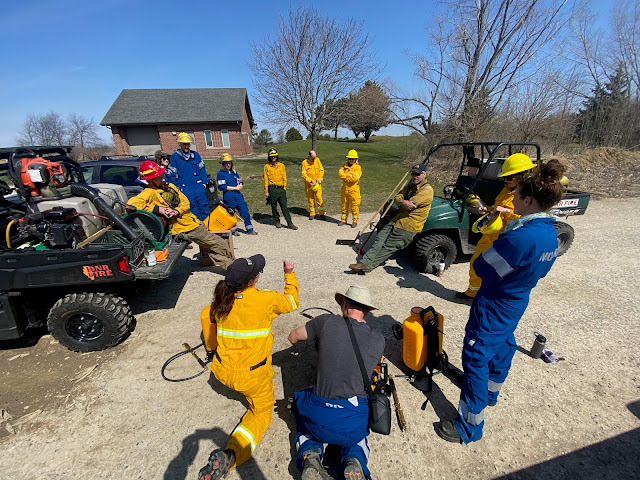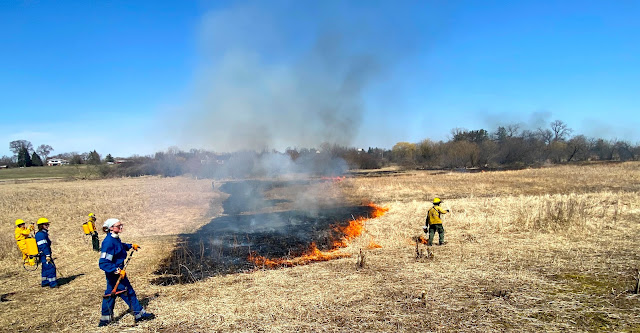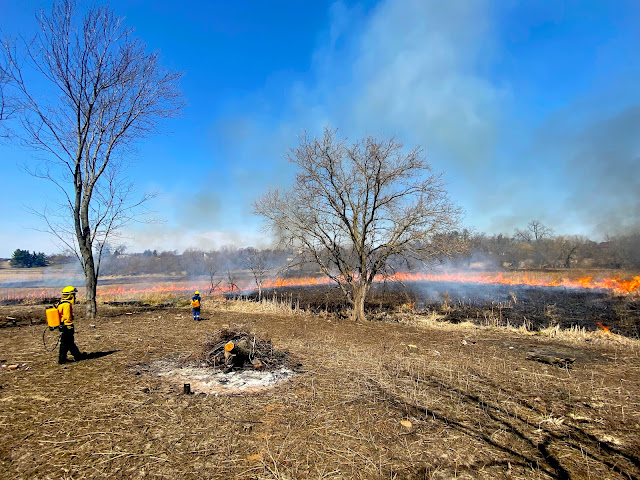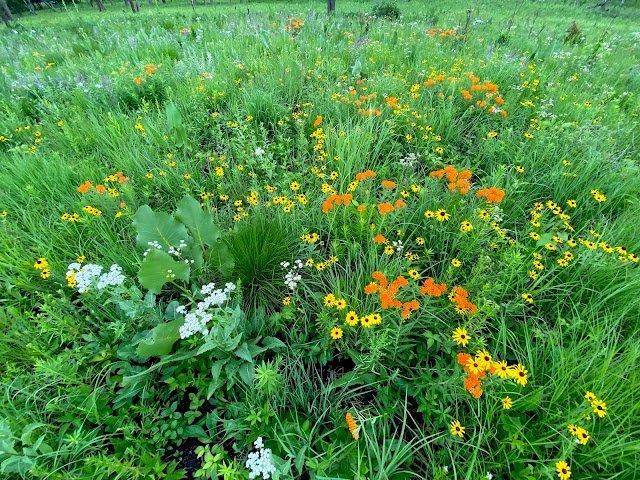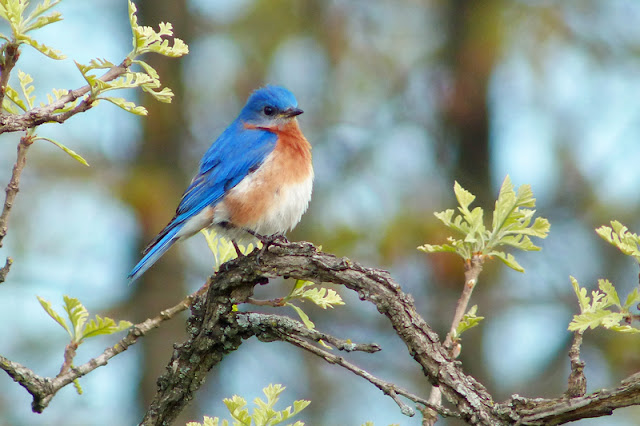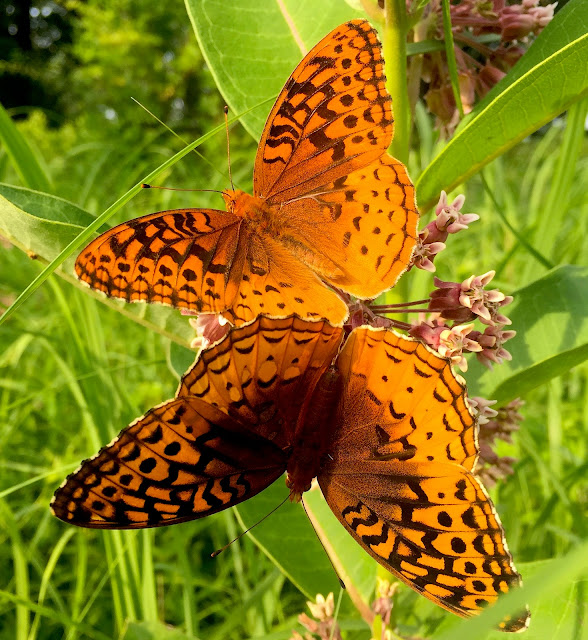Prelude
“The prararies in the summer present one vast natural garden of delights spreding before the aye such a butiful and varagated senery decked with flowers of evry shape, sise, hugh, that they that could not admire them must be destitute of a sence of beauty and elegance.”
The spelling is iffy. But this 1839 letter from James and Sarah Smith, captured the prairie. The rest of that letter is about commerce, sickness, relatives, hard work, and land prices (see Endnote 1). But forever, a bit of the ancient grassland lives in those words.
Many settlers left us haunting, suggestive descriptions that let us know that they recognized something that was beyond the experience of Europeans and easterners - the tallgrass prairies, savannas, and woodlands - richest natural ecosystem of the temperate world. Today few have seen the remnants of that nearly-lost, ancient nature.
The photo below may suggest what the 1839 language sought to convey.
But each photo captures only one moment. Part of the magic is that the richness unfolds and changes dramatically every day of the growing season. The rest of this post shows a year at Somme Prairie Grove, moment by moment. This prairie-savanna-woodland ecosystem is trying to recover something nearly lost from the Earth. (Really? Lost from the planet? See Endnote 2.)
And Now:
One Growing Season of Images from Somme Prairie Grove
Seven Months in a Restored Grassland Garden of Eden
As the growing season starts, every year, April gives us a snowstorm or two.
The early plants are not fazed.
This one is bellwort.
We stewards aren't fazed either. Snow flurries don't stop us.
Month by month, year by year, the deadly invasives retreat and burn.
But when the delicate flora emerges, we soon switch to work that requires less trampling.
April 12 - in the woods
Bloodroot in bloom.
The thin leaves are Toothwort, which will bloom next.
The big leaves are Wild Leek, which won't bloom till mid-summer.
April 28 - in the woods
In the woodland, the early plants are in full swing.
Toothwort blooms by the thousands. Wide-leaved leeks will bloom later.
Bloodroot is long past bloom, one lobed leaf showing here at bottom of photo.
Yellow woodland violet blooms in center with wrinkled leaves.
The woodland comes into full flower well before the prairie and open savanna - as if the grassland plants were scared of a late fire. Early woodland wildflowers need to get much photosynthesis done before the leaves appear on the trees and begin capturing much of the light. This woodland had been all buckthorn, with none of the above species surviving until they were restored by cutting, fire, and seeding.
May 3 - in the savanna
In the nearby grassland, early bloomers rise just an inch or three from the ground. Here: the rare Prairie Violet (note blue flowers and deeply cut leaves) and the five-petaled Violet Wood Sorrel, a rare plant of of fine woodlands, savannas, and prairies.
May 7 - back in the woods
Blooming: Bellwort (yellow) and Large White Trillium.
Leaves of Wild Leek, Cow Parsnip, Toothwort, and Penn Sedge.
May 12 - in the woods
Shown above: Rue Anemone (white), Yellow Woodland Violet (yellow), and the leaves of Shooting Star, appearing huge here, next to sweet little rue and violet.
May 14 - in the prairie
Finally coming to life in mid May.
Oh how agonizingly slowly emerges the prairie.
We - for inspiration by the miracles of life - in early May mostly remain in the woodland.
Yet, there's much to learn in this photo.
The big wide leaves are Shooting Star, soon to bloom.
The clusters of small wide leaves nearby are young Shooting Stars.
Most of these too-dense plants won't survive to adulthood; they live for a while where the seed of the mother plant fell densely. As this is a young restoration (only four decades old), it's still in the early stages of diversity re-establishing itself, a slow process, profound and awesome to watch.
Shooting star, instead of isolated dense patches of young seedlings, will be common, everywhere, but mostly spread well apart, in the growing diversity.
A companion to the photo above - in the prairie or open savanna.
In this spot Prairie Violet is everywhere - but Shooting Star nowhere.
One hundred years from now it seems reasonable to predict that both plants will be in every square yard, or at least in every square meter, if we're metric by then.
These species are that common in fine prairie and open savanna.
Other high-quality species visible here, indicating progress toward recovery, include Bastard Toadflax, Compass Plant, Prairie Dropseed, and Rough Blazing Star.
There's also wild strawberry, Indiangrass, and rigid goldenrod, which are nothing to write home about, but do contribute to diversity in the long run.
A Note on Dates
These photos are dated when I have the dates handy. They're the real dates of these photos. But don't expect them to be accurate for all years. Bloom dates differ from year to year and place to place, partly in response to the year's weather, partly in response to landforms (for example south-facing slopes bloom before north-facing) and recent fire history: a burned prairie emerges and blooms a couple of weeks earlier than the unburned.
A Note on Animals
This post focuses on the vegetation, which you can see every time you visit.
Occasional photos like this Eastern Bluebird are reminders that animals, fungi, rare bacteria, and all manner of other biota worth conserving are crucial, whether visible or not, to this recovering habitat.
May 17 - in the prairie
Small White Ladyslipper blooming with Violet Wood Sorrel and Yellow Stargrass.
In a good season, this lady-slipper clump would have a dozen blooms. This year it had just one.
The previous growing season presented two challenges, no burn and poor rains during the lady-slipper's prime growing season.
Next year we may well see it at full strength again.
May 26 - in the savanna
Shooting Star
May 27
Hoary Puccoon (yellow-orange), Bastard Toadflax (white), and Blue-eyed Grass (pale blue).
Leaves of Prairie Violet, Prairie Rose, and Prairie Dropseed Grass.
Wild Columbine (red) grows mostly in the dappled shade of the savanna.
Golden Alexanders (yellow) grows in prairie, savanna, and woods.
May 29
Violet Wood Sorrel and Yellow Stargrass in bloom, both happy in prairie, savanna, or woodland.
The carrot-looking leaves to the right belong to the less-broadly-adapted Thicket Parsley, telling us that this photo is from open woods.
As Shooting Star begins to mature seed, the burly Cream False Indigo bursts up, fully formed as the shoots leave the ground and leaves and flowers quickly unfurl.
June 8
Cream False Indigo and Downy Phlox
Canada Anemone, Wild Geranium, and slithering vine of River Grape.
In the savanna, vines mix with wildflowers, grasses, shrubs, and trees.
June 9 - near the woods edge
Purple Twayblade orchid
June 25 in the savanna.
White - wild quinine. Yellow - black-eyed Susan. Orange - butterfly-weed. Wide leaves - prairie dock. The grass here is mostly Indiangrass and prairie dropseed.
June 25 - savanna detail
Prairie Lily is one of the most
conservative prairie and savanna plants.
Few prairies today have even one.
Guantanamo For Conservatives
The rarity of some species may be caused in part by our region's out-of-balance deer populations. Some species are so sought by deer, that every plant gets eaten entirely. Their roots survive, but not forever, if that assault continues annually. We cage them, reluctantly, with two potential hopes. The first is that our culture will increasingly decide that we need to substantially reduce excessive deer populations. The second is that we can foster population increases of the rare plants to such a level that reduced, more-natural numbers of deer can eat them freely. Actually, we hope for both. See Endnotes 3 and 4.

In 2007, only two prairie lilies bloomed in Somme Prairie, down from more than twenty annually, before the deer became so numerous. So we started caging and propagating. Numbers in the savanna of Somme Prairie Grove are up from zero in 2002, when we first restored them there, to more than 50 plants in bloom last year. The lily shown above shares the stage with Prairie Coreopsis, Leadplant, and Wild Quinine. Leaves of Compasplant, Prairie Dock, Indiangrass, and Prairie Dropseed.
June 28
Dead trees in the background are invasive species, killed by fire.
In the left foreground here are burned, shrubby clumps of Hill's Oak - a species that is natural in the savanna but tends to frequently burn off and start over, shrublike.
In the savanna, scattered fire-surviving trees (mostly Bur Oaks) leave plenty of light for other vegetation.
Blooming above, from the bottom, Leadplant, Black-eyed Susan, Butterflyweed, Wild Quinine, and Compasplant.
July 4
Prairie White-fringed Orchid
July 9
Mating Great Spangled Fritillaries.
Caterpillars of this savanna species feed on the leaves of violets.
Purple Milkweed is one the Fritillary's favorite nectar sources.
July 10
Purple Prairie Clover (pink), Early Goldenrod (yellow), Mountain Mint (white), and Wild Bergamot (lavender) blooming among Prairie Dropseed grass. The Leadplant was purple, now making seeds, and looking kind of gray.
In the foreground is a big Compassplant. But the stars of this photo are the prairie clovers, purple and white. Purple Prairie Clover is a rare and conservative plant. But White Prairie Clover is a
very rare and conservative plant. Indeed, a gratifying triumph of the Somme Prairie Grove restoration is the fact that the quality plants year after year get more abundant. White Prairie Clover started very slow. We had found very little seed. But bit by bit, year by year, it has flourished and spread.
This photo shows three important features of the site.
On the right is the Inner Loop footpath. If you like "being in nature" - these paths may be for you. If you prefer a wide mowed or paved trail, well, what can we say?
On the near horizon is a strip of large trees. Those planted trees are
unnatural to this site. In recent years we've spent time gradually thinning them to savanna density and encouraging young bur oaks there. Dense trees are common in untended wild lands. The tallgrass savanna - with its widely-spaced trees and associated animals, plants, and other biota - is globally rare, barely at the level of sustainability. Expanding this savanna habitat (and thus increasing the populations of tallgrass savanna species generally) is a priority for us and for global conservation. Endnote 2 has more on this.
A third feature is visible through that little gap between the trees. We see out from the savanna and into the prairie. For more on the larger context, see Endnote 5.
July 13
Illinois Rose
Blooming in impenetrable thickets near the edges of woodlands.
July 13 - in the savanna
New Jersey Tea (white, top left) blooms with Butterflyweed, Wild Quinine, and Leadplant.
Foliage here includes Cream Gentian, Hill's Oak, Prairie Dropseed, Kalm's Brome, Tall Coreopsis, Woodland Sunflower, and Meadow Rue.
In open savanna.
Above, starting close and working back:
Leadplant, Wild Quinine, Butterflyweed, Rattlesnake Master, Black-eyed Susan, and Early Goldenrod.
Canada Milk Vetch blooms in open savanna near the edge of the woodland.
Compass Plant, Gayfeather, Rattlesnake Master, Mountain Mint, Early Goldenrod, Black-eyed Susan, Wild Bergamot, Big bluestem.
July 24
Purple Prairie Clover, Rattlesnake Master, and the dainty Early Goldenrod.
Somme has fifteen species of goldenrods. Only one is a big weedy pest.
The conservative ones deserve more appreciation than they often get.
July 31
Tiger Swallowtail on Rattlesnake Master.
Its caterpillars eat the leaves of willows, cottonwoods, and cherries.
Woodland Joe Pye Weed, Woodland Sunflower, Bur Oak.
August 12
In young wet-mesic prairie.
Sweet Black-eyed Susan (yellow) blooms with Culver's Root (white), Ironweed (purple), and Riverbank Wild Rye (pale green). It's colorful but a bit rank. It will in time become more diverse in conservative species - and more restrained and complex in structure.
Near the previous photo, the prairie merges into the savanna.
In bloom: Cowbane (white), Spotted Joe Pye Weed (pink), Sweet Black-eyed Susan (yellow).
The closest tree is an elm, with no main trunk and ascending, subdividing limbs.
Those on the ridge are Hill's oaks.
August 24
Forked Aster (an Endangered species)
As with goldenrods, there are more species of aster than most people have the patience to learn.
Some are white, some pink, some blue.
Once you've learned them though, they do enrich.
September 1
Forked Aster blooms among Elm-leaved Goldenrod, Purple Joe Pye Weed, Woodland Brome, and Tall Coreopsis.
September 11
Now the Indiangrass and Big Bluestem have reached their heights. often as tall as you or me.
We feel somber as the growing season is heading for its close.
September 24
Prairie Gentian.
"A deep and hurtful blue."
Last glorious bloom of the prairie and savanna year.

The Bur Oak (bare branches, left) drops its leaves rapidly as fall starts. Hill's (or Scarlet) Oak keeps its leaves all winter. There are contrasting strategies here. Bur oak leaves accumulating on the ground are fuel; they increase the chances that the area of that bur oak will burn. Fire is the main weapon the thick-barked bur oak uses to protect itself from overgrowth by other species of trees - none of which the bur can compete with in the absence of fire. A companion species, Hill's oak has thin bark and is "top-killed" easily by a burn. By keeping its leaves off the ground, a Hill's oak may be spared injury by a creeping ground fire. But a vigorous fire will burn the whole tree - and anything above it - which is also of benefit to the Hill's oak. It too cannot compete well in the shade of most other species of trees. But it is a champion re-sprouter after fire. Hill's oaks on the savanna may live for decades as re-sprout oak bushes, like the many re-sprout clumps in this photo. Occasionally, chance occurrences allow one to graduate to life as a bigger tree (like that one in the background), for a while.

October 22
Ready for a burn, whether in fall or the following spring.
Prairie Dropseed grass is known by its big clumps of very fine leaves.
Little Bluestems are the reddish clumps.
All the prairie, savanna, and woodland wildflowers are now fuel.
Many of us, every year, find ourselves deeply moved by the expression of planetary richness that is offered by the preserved and restored ecosystems of the tallgrass region. To paraphrase the 1839 letter that launched this post, it's a great pleasure for us to share this "butiful and varagated senery" with all who are not "destitute of a sence of beauty and elegance."
It's been a rich and miracle-filled growing season. Indeed, they all are.
Endnotes
Endnote 1.
The letter quoted at the beginning is all the more compelling in context of the challenges faced by the new immigrants. From James and Sarah Smith, postmarked Elkhorn Grove, Illinois, 1839:
MR. DAVID PORTS,
Boonsborough, Washington County, Md.
Dear Brother, I once more take up my pen to give you some information of our afairs and the far west to which we have straid. We landed at Savanna with father the time I toled you in my last; he landed with $500 and his mair, waggon, and harness which he soled for $165 more making in all a capitol of $665; his 300 acres of land he intended to get has dwindled down to about 3/4 of an acre one of which he proffered me but I declined accepting it thinking he would kneed it himself if he lived to get olde. He built himself a log house on one of his lots into which he moved the 7th. of July without a cent to bless himself and to cap the monstrous climax he and mother ware maried the 1st of Jan. last. You may ask me what I have done (who landed with only one dollar in my pocket and $30.00 of olde debts on me) Well I will tell you I began to work, and as I worked I lived in the olde fashion way from hand to mouth at the following rates, flour $10 per barrel, bacon 14 cts, per lb. beef 9 and mutton 7 and notwithstanding we had four months sickness (dureing which time I was doctor, nurse and cook) we still live to the preys of him whose tender mercies are over all his works, and eat our own corn and pork In addition to that I have 35 acres of prararie as good as any man could wish every foot of which can be cultivated without the annoyance of stump or stone and 5 of timber and a good log caben all for $60 most of which is paid.
I also have 10 lots in Elkhorn city at 125 dollars on a credit of two years to pay it in. We moved to this grove the 2 of Jan. Since that time we have been in good health. Sarah Ann weighs 120 lbs. and I 183 sinse we came to this place we have done better than we ever did in twice the time before. Respecting our country I am afraid to say anything lest I should not be believed; however I will venture an expression of opinion. The prararies in the summer present one vast natural garden of delights spreding before the aye sush a butiful and varagated senery decked with flowers of evry shape, sise, and hugh, that he that could not admire them must be destitute of a sence of beauty and elegance.
Levina has got 5 acres of timber and 5 of prararie for 30 dollars and the prararie broke for her bed. She has lived with us all winter within 4 weeks back when she went out for work for $2 per week. Father and mother are well ...
Endnote 2.
Can it be true? These ecosystems are nearly lost from the planet? What technically is the status of the tallgrass ecosystems?
There exists in "The Prairie State" no high quality prairie on good soil that is bigger than a few acres. Less than 1/100th of 1% of the original survives. A grassland that small is probably not sustainable as a rich ecosystem, as it misses most of its interdependent animals, especially pollinators and insect predators. It's also too small for many needed evolutionary processes that are needed to deal with climate change, acid rain, fragmentation, disease, etc. Efforts are under way at many preserves to restore as much surrounding acreage as possible to foster sustainably large populations and the capacity for continued evolution.
Large areas of sand prairie and sand savanna survive, and heroic efforts rightfully continue to conserve them too, as fully as possible. But this post concerns "black soil" or "rich soil" ecosystems, which once covered most of the state - but now are so much rarer.
In even worse shape than the prairie, high quality black-soil savanna is entirely gone. But substantial acreages of degraded remnants still exist. Four decades of restoration at Somme Prairie Grove Nature Preserve suggest that a great deal of
the biota can revive with good care. Most of the photos in this post are from the savanna portions of that prairie-savanna-woodland complex.
High quality oak woodland of the tallgrass region is so rare that it has been considered by The Nature Conservancy, NatureServ, and others to be our region's only "G1S1" Globally Endangered Ecosystem. Large areas of degraded former oak woodland survive and very much deserve appreciation and restoration.
Endnote 3.
Some of the species that suffer badly from excessive browsing by white-tailed deer:
Prairie lily
Prairie white-fringed orchid
Prairie lady-slipper
Prairie gentian
Fringed gentian
Eared False Foxglove
Veiny pea
And many more.
Bur oak reproduction is badly suppressed not only by shade of faster-growing (but fire intolerant) trees - but also be excessive deer browse. Many oaks that we have watched suffer from this are still less than two feet tall after four decades. So we provide "deer exclusion cages" to help them get above deer height, but the better overall solution is more predation (necessarily by people these days) and fewer deer.
Also, unexpectedly, many ground-nesting birds suffer from deer overpopulation, in part because the deer eat nestlings that they find, and in part because of the degraded habitat left behind by overgrazing.
Endnote 4
What does predation mean in the tallgrass region today? It has no wolves or mountain lions. There seems to be no practical alternative to culling them, despite opposition expressed by some. Congratulations to Village of Northbrook and Cook County Forest Preserves for their deer-control programs. Congratulations to Lake County Forest Preserves for establishing a model of transparency and public education. All deer culled for population control by public agencies in Illinois are prepared for distribution through food banks to people who need better nutrition than they can afford. For the natural ecosystem, deer control is a matter of life and death, and there needs to be much more.
Endnote 5
Prairie begins toward the west edge of Somme Prairie Grove Nature Preserve (see aerial photo, below) and continues on the other side of the railroad tracks and the ditched former prairie river to Somme Prairie Nature Preserve on the west. Especially for species that need more than one habitat, the combined presence of prairie, savanna, and woodland here is an important feature of these three preserves.
As Greg Spyreas put it in a publication of the Illinois Natural History Survey:
Narrow foot trails that cover 3.5 miles through Somme Prairie Grove's 85 acres (east of the train tracks) pass through hazelnut and viburnum thickets, with ancient bur and scarlet oaks overhead, and purple Joe-pye-weed and bottlebrush grass below. At Somme Prairie (70 acres, west of the tracks) the sharp, green boundary between the best preserved prairie and the grassier, less diverse sections illustrates where the prairie lost wildflower species after years of farming ... Excellent trail guides to these areas can be found online. Along with the 250-acre Somme Woods Forest to the east, the slow return to health with prescribed fire, seeding reintroductions, and invasive species removal in this preserve has been breathtaking to behold.
If you don't know the site, this aerial might be helpful. Somme Prairie (originally all prairie) is on the left (behind the Northbrook Post Office). East of the railroad tracks is Somme Prairie Grove (originally mostly savanna). Then further east, across Waukegan Road, is the larger Somme Woods (originally savanna to the west and north, and mostly open woodland to the east).
Acknowledgments
Thanks to the staff of the Cook County Forest Preserves for doing the controlled burns and generally being great partners with the volunteer stewards in the restoration of the Somme preserves.
Thanks to Lisa Musgrave for the photo of the eastern bluebird on the bur oak branch.
Thanks to Eriko Kojima for proofing and edits.
